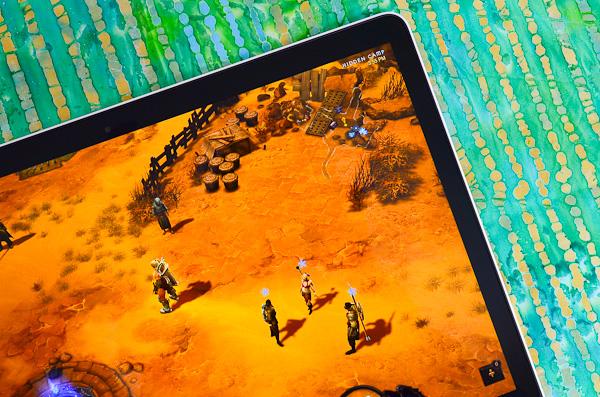The next-gen MacBook Pro with Retina Display Review
by Anand Lal Shimpi on June 23, 2012 4:14 AM EST- Posted in
- Mac
- Apple
- MacBook Pro
- Laptops
- Notebooks
Achieving Retina
To make the MacBook Pro’s Retina Display a reality Apple had to work with panel vendors to build the panels it wanted at a reasonable cost, as well as deliver the software necessary to support insanely high resolutions. There was another problem Apple faced in making the rMBP a reality: the display pipeline of the GPUs Apple wanted to use didn't officially support scaling to the resolution Apple demanded of them. Let me explain.
All modern GPUs have fixed function scaling hardware that is used to efficiently scale between resolutions. A scaler either in your GPU or in your display panel is what lets you run non-native resolutions at full screen on your LCD (e.g. running 1680 x 1050 on a 1920 x 1080 panel). None of the GPUs used in the Retina Display MacBook Pro officially support fixed-function scaling of 3840 x 2400 or 3360 x 2100 to 2880 x 1800 however. Modern day GPUs are tested against 2560 x 1440 and 2560 x 1600, but not this particular 5MP resolution. Even 4K resolution support isn’t widespread among what’s available today. Rather than wait for updated hardware and/or validation, Apple took matters into its own hands and built its own GPU accelerated scaling routines for these higher resolutions. Fixed function hardware is almost always more efficient from a performance and power standpoint, which is why there’s some additional performance loss in these scaled resolution modes.
What’s even crazier is Apple wasn’t pleased with the difference in baseline filtering quality between the Intel HD 4000 and NVIDIA GeForce GT 650M GPUs. As the Retina Display MacBook Pro would have to regularly switch between GPUs, Apple wanted to ensure a consistently good experience regardless of which GPU was active. There are a lot of filtering operations at work when doing all of this resolution scaling, so rather than compromise user experience Apple simply wrote its own default filtering routines. Since you want your upscale and downscale quality to be identical, Apple had to roll its own implementation on both. Apple’s obsessive attention to detail really made it possible to pull all of this off. It’s just insane to think about.











471 Comments
View All Comments
dannyboy153 - Saturday, June 23, 2012 - link
The Sony Z is more of a "consumer" laptop than a creative laptop. Here's why:1) The 1080p (9x16) LCD is great for watch movies but the loss in 1" vertical height is annoying.
2) No discrete GPU built into the Laptop.
3) No high res output. VGA and HDMI doesn't cut it. I have no idea why their dock doesn't have DVI or display port even though it's equipped with a discrete GPU. Their implementation of the dock is admirable, but it's filled with bugs. Read the reviews.
I'll have to admit the MBP is heavier by almost 2x the weight of the Sony Z. But at ~4.5 lbs, it's not overly heavy. MBP advantage:
1) None of the disadvantages of 1-3 above.
2) 15.4" screen is HUGE for me (coming form an X200). Also, it's like the best of both worlds for glossy and matte LCDs; beautiful and vastly reduced glare.
3) The Sony Z has a quad core but the MBP is more powerful. Notice I didn't mention the weaker Quad core of the Sony Z as one of its disadvantage because I believe it's hard enough for them to even offer such power in their laptop.
ananduser - Saturday, June 23, 2012 - link
The 2010 VaioZ had discrete video, 1080p screen, quad raid SSD option. blu ray, slim profile, etc.The 2012 VaioZ does not have discrete built in, only via external dock.
So...considering what the Z was for 2010, Anand never sang such high praises for it. Why ? Because he's a macuser and couldn't care less about another company's efforts.
OCedHrt - Sunday, June 24, 2012 - link
http://www.anandtech.com/show/5430/sony-vaio-z-wit...They did eventually do a review of the 2011/2012 Z, however they're not as tolerant of small faults as they are with apple products.
I remember back in the day when Anand would wipe the floor about keyboards not having enough pitch. But on the macbook pro retina the reduced pitch is just "different" not terrible.
gstrickler - Sunday, June 24, 2012 - link
The MBP keyboard doesn't have reduced pitch, it's a standard 19mm pitch. It has slightly reduced key travel.OCedHrt - Monday, June 25, 2012 - link
Sorry I meant key travel. Incorrect use of terms on my part.dannyboy153 - Sunday, June 24, 2012 - link
For 2010, there were plenty of laptops with 1080p. Name one laptop now with the Apple's display. The Z is a great laptop if you're a consumer of media. But for creators, the Apple is superior.Spunjji - Monday, June 25, 2012 - link
Name another *13"* laptop in 2010 with 1080p. Go on. We can play this game all day!SanX - Saturday, June 23, 2012 - link
hdmi can not handle 1080 output?dannyboy153 - Sunday, June 24, 2012 - link
I don't consider 1080p hi res. At a minimum it has to be at least 1200p in 10x16 format for 24" monitors. For the price of the Sony Z, not being able to do 2560x1600 is a shame.OCedHrt - Monday, June 25, 2012 - link
Reading on forums there doesn't seem to be any issues with 1920x1200 external output, but 2560x1600 does not work without a hack for reduced refresh rate.